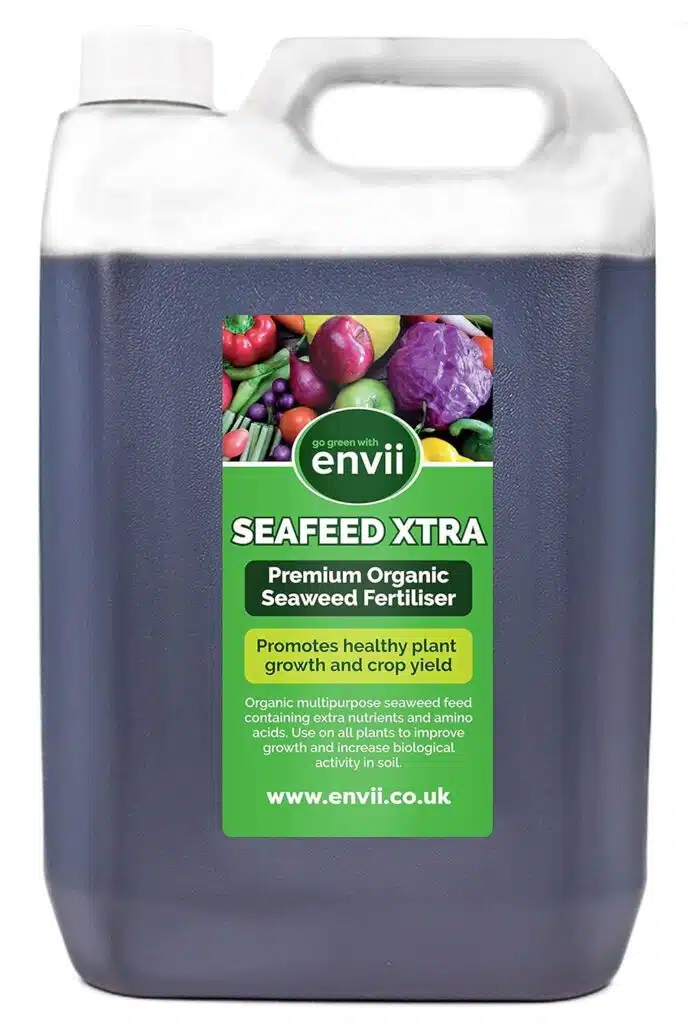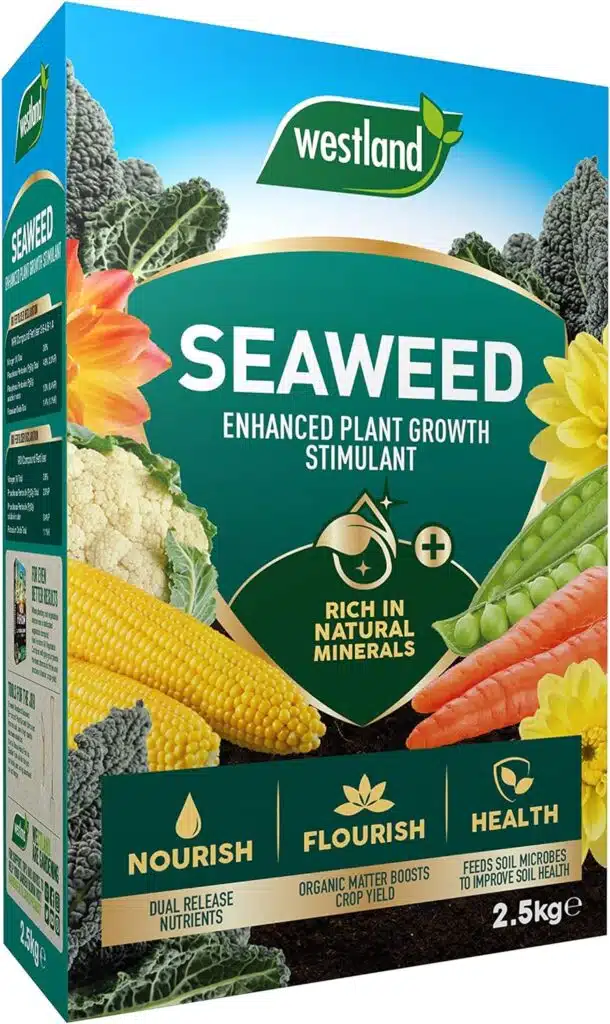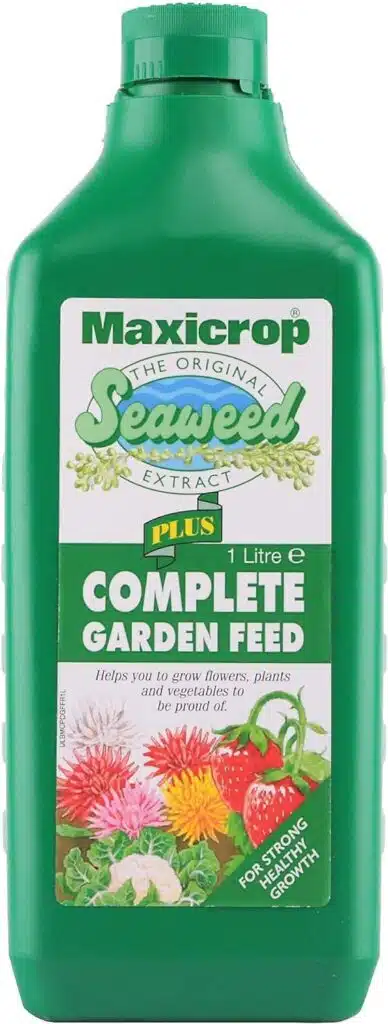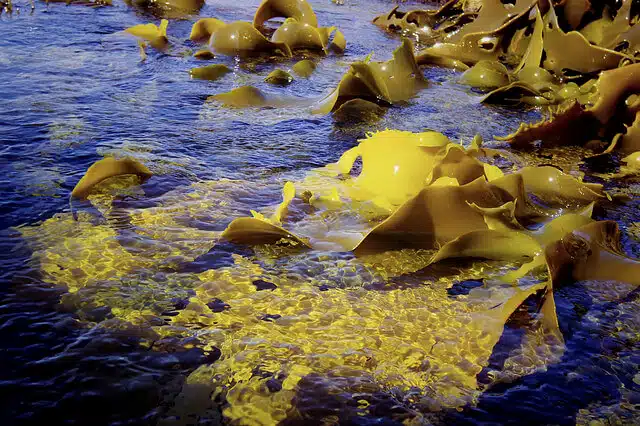I highly recommend seaweed fertiliser, whether you’re growing in containers or in the ground. It’s packed with micronutrients and completely natural. It’s a sustainable, harm-free way of adding plant-beneficial goodies to your soil.
It’s part of my essential kit for gardening in containers and I wouldn’t go without it. I prefer the calcified version that can be mixed into the top few inches of a pot, and which breaks down over time, but there are lots of other alternatives. Many gardeners favour the liquid version.
In this article I want to offer some general information about using seaweed fertilizer as well as tell you about my favourite picks from around the web. Let’s dig in.
The Short Version: Best Seaweed Fertiliser
Click here to jump to our reviews of some of the best seaweed fertilizers from around the web.
- envii Seafeed Xtra (££) (Top Pick)
- Westland Seaweed Enhanced Plant Growth Stimulant (Granular) (£)
- Maxicrop Complete Garden Feed (£)
What Is Seaweed Fertiliser?
Seaweed fertilizer is usually a kelp-derived soil-additive that is rich in micronutrients (it also has NPK content). It has been used for a very long time, especially by farmers that live near the coast, and can be prepared in a number of ways. You can even add kelp directly to the soil (but it might take a while for it to break down).
Generally speaking, there are four main ways you can buy seaweed fertilizer:
- Liquid seaweed – Liquid seaweed is probably one of the best options for container growers because applying liquid feed will mean that plants can access nutrients quickly. It is produced by soaking and straining kelp in water.
- Seaweed/kelp meal – Seaweed meal is made by drying the seaweed and, in the case of powder, crushing it.

- Seaweed extract powder – Powder is usually made by heating seaweed so as to get rid of all the water content. What is left is a solid, highly potent form of feed.
- Calcified seaweed – Calcified seaweed isn’t made from kelp. It consists of various types of calcified coral and certain types of algae that are harvested from the sea. It consists of around 50% calcium along with the usual minerals so beneficial to plant growth. A lot of the nutrients are directly available to plants (they don’t have to be broken down by bacteria).
The case for container gardening
As I’ve already mentioned, I like seaweed fertilizer. It’s not synthetic and it doesn’t include any animal products. It’s a real godsend for container growers too. A lot of the popular commercial feeds don’t contain a significant amount of trace elements. Because container growers often need to rely on liquid feed, it’s important that they find a way of adding micronutrients.
Here are some general tips to make sure that your container plant feeding is successful:
- Use seaweed fertilizer in addition to a normal balanced fertilizer. It doesn’t contain hefty amounts of the main plant nutrients (nitrogen, phosphorous and potassium) so needs to be supplemented.
- I don’t follow any hard and fast rules when it comes to the amounts of granular fertilizer I apply. Usually a small handful suffices, sprinkled around the plant and forked in.
- Apply liquid fertilizer weekly through the growing season. For herbs and perennials tone it down to bi-monthly. Feed monthly or not even at all through winter and at half-solution through early spring/late autumn.
- You can buy fortified products, where extra NPK is added. If using a feed of this type, you don’t need to supplement with anything extra.
- Always check that your fertilizer comes from a sustainable source if that’s something you’re concerned about. It usually does but there’s no harm in double checking.
- Personally, I don’t bother with foliar application or misting. The only exception to this is in an emergency when one of my plants is showing signs of nutrient deficiency.
- I also tend to advise the use of liquid seaweed for container growers because kelp meal needs to be broken down by bacteria in the soil, which often aren’t present to the same extent in container media.
What about “making” your own?
Seaweed isn’t just good for plants. It seems that it’s healthy for anybody (or anything) able to get their hands on it! But seeing as the focus of this site is plants, I’d better stick to that application…still send in the recipes if you have any!
Seaweed breaks down easily in the soil, supporting microorganisms that assist in its decomposition in the process. I have to confess that I don’t know that much when it comes to ethically and sustainably collecting seaweed for use in your garden. If you know of anywhere that grows it for commercial use, I’d be tempted to use them. My understanding is that it’s OK to collect seaweed from the shore that has washed up. Storms apparently tend to dredge up huge quantities of the stuff.
You can of course always add it to your compost heap too! You can add partially rotted-down seaweed to the top of pots for a quick boost, where it will continue to break down.
Best seaweed fertilizers: Some picks from around the web
***Full Disclosure – Where appropriate, I’ve linked product images to commercial sites and Amazon (see Amazon Disclosure). If you buy from these sites, I earn a small affiliate fee, which helps me keep Urban Turnip going.***
1. envii Seafeed Xtra

I had three criteria for my top pick. First, it had to have a good dilution ratio. This dilutes at a ratio of 1 part fertiliser to 50 parts water. So 60ml for a standard 6 litre watering can.
Second, it had to be available in different quantities, making it suitable for growers of all stripes, from balcony gardeners to allotmenteers. You can get envii Seafeed extra in 1, 5, 10 and 20-litre bottles. If you want to save money by buying in bulk, you’re covered.
Finally, it had to have clear instructions. Separate dilution ratios are given for different plants. The smaller bottle even has a built-in measuring mechanism, letting you can pour it straight into your watering can.
It’s also organic. The seaweed is harvested at certain times of the year to maximise nutrient density.
This is the liquid seaweed feed that I use in my garden, and I can’t recommend it highly enough.
Westland Seaweed Enhanced Plant Growth Stimulant

If you prefer a granular seaweed fertiliser, which you’ll only need to apply every 4 to six weeks (liquid feed will typically need to be applied every week), then this granular feed from Westland is an excellent choice.
It can be tempting to search for non-branded product, but I’ve compared Westland with other lesser-known products and it beats them all on price.
You’ll get 2.5kg of feed and the instructions are to fork in two handfuls per square metre of soil (I’d add one half a handful per large pot).
Finally, it’s grown sustainably from seaweed harvested in Ireland, which is another plus.
3. Maxicrop Complete Garden Feed

This feed from Maxicrop is a complete fertiliser with seaweed extract added.
Unlike the other entries, it has a balanced NPK profile. This means you won’t need to add any base fertiliser to your feeding regimen.
It’s a good product from a well-established brand. It dilutes at a ratio of 1:30 (30ml per 9 litres of water), so you get a decent amount of feed per bottle. It can be applied either as a root drench or a foliar spray. Cap measurements are provided for diluting in a watering can.
If you’re looking for a complete fertiliser that provides all the benefits of seaweed, Maxicrop is a solid choice.
Let us know your thoughts! Leave a comment below!
What are your thoughts? Have you tried any of the fertilizers above? Leave a comment below and let me know!
Image credit: Kelp by Mariell Jüssi.

We would like to buy seaweed fertilizer, where can we get it in Australia.
Please let us know.
Thanks, Herlina
Hi Herlina. I’m not familiar with Australian brands BUT there are a few different names for similar products: kelp meal, calcified seaweed, liquid seaweed. All are a little different and will need to be prepared differently but they all do more or less the same thing.
Seasol is a fantastic liqued seaweed fertilizer, available at bunnings, potentially some supermarkets
Thanks for the tip!
Of the NPK fortified varieties, which (if any) would you recommend?
Thanks,
Jay
Hi Jay. I wouldn’t really recommend going for a “fortified” variety as such. Either you want to supplement a full NPK feed with seaweed, or get an NPK feed with micronutrients. You’re unlikely to provide your plants with the necessary nutrients with a seaweed feed with NPK added.
I have known about Maxicrop soluble seaweed power for many years, and have used it for the past couple years. I was surprised that I didn’t see any mention of Maxicrop in your review.
Hi Ron. I’ll take a look. Thanks for the suggestion.
In the chart, what do you mean by $$ sign in price section?
kindly inform me.
Hi Tushi. The ££ sign refers to the comparative price of the product: one for low, two for medium, and three for high. It’s just a rough guide.
Thank you for the tips and all your efforts you put in this blog. I really appreciate it. I have been following your blog for a while and it has helped me a lot.
Thanks Aakrati!